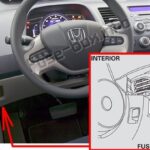Experiencing issues with your Honda Civic 2014 failing a smog test due to readiness monitors not being ready? You’re not alone. Many Honda Civic owners face this situation, often stemming from disconnected batteries or recent repairs that reset the car’s computer. The solution often lies in performing an OBD-II drive cycle. This process allows your vehicle’s onboard diagnostic system to run comprehensive checks, ensuring all systems are functioning correctly and setting the necessary readiness monitors. Understanding the OBD2 port and how to execute a proper drive cycle is crucial for passing your emissions test.
The OBD-II drive cycle is a specific set of driving conditions designed to allow your car to complete its self-diagnostic tests. It’s initiated from a cold start, meaning the engine coolant temperature needs to be below 122 degrees Fahrenheit, and the air and coolant temperatures should be within 11 degrees of each other. It’s important to ensure the ignition key is not turned on before the cold start to allow the heated oxygen sensor diagnostic to run correctly.
Here’s a step-by-step guide to performing the OBD-II drive cycle on your Honda Civic 2014, ensuring you utilize your OBD2 port effectively for system checks:
-
Initial Idle: Start your Honda Civic 2014 and let it idle in drive for two and a half minutes. Ensure the air conditioning (A/C) and rear defrost are turned on during this phase. This step allows the OBD-II system to check the oxygen sensor heater circuits, air pump, and EVAP purge system.
-
Moderate Acceleration and Steady Speed: Turn off the A/C and rear defrost. Accelerate smoothly to 55 mph using about half throttle. This engages checks for ignition misfire, fuel trim, and canister purge. Maintain a steady speed of 55 mph for three minutes. During this constant speed, the OBD-II monitors the EGR system, air pump, O2 sensors, and canister purge functions.
-
Deceleration: Without braking or depressing the clutch, allow your Honda Civic 2014 to coast down to 20 mph. This deceleration phase allows the OBD-II system to check the EGR and purge functions again.
-
Re-acceleration and Steady Speed: Accelerate once more to between 55 and 60 mph using half throttle. This step re-initiates checks for misfire, fuel trim, and purge system operations.
-
Extended Steady Speed: Maintain a steady speed between 55 and 60 mph for a longer period of five minutes. During this extended phase, the OBD-II system comprehensively monitors catalytic converter efficiency, misfire occurrences, EGR system, fuel trim adjustments, oxygen sensors, and purge functions.
-
Final Deceleration and Stop: Finally, decelerate and come to a complete stop without using the brakes. This last coast-down allows the OBD-II to perform a final check of the EGR and canister purge systems.
By diligently following these steps, you’re enabling your Honda Civic 2014’s OBD-II system, accessed through the OBD2 port, to conduct all necessary diagnostic tests. Completing this drive cycle correctly increases the likelihood of your readiness monitors setting, allowing you to pass your smog test. Remember to consult your Honda Civic 2014 owner’s manual for the precise location of your OBD2 port if needed, although it is typically located under the dashboard on the driver’s side. This process is a vital step in ensuring your vehicle meets emission standards and operates efficiently.
